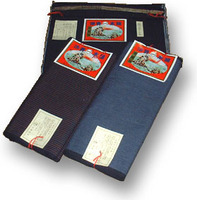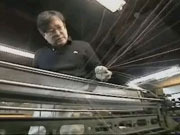

Total:131items
- Pottery & Porcelain (18)
- Lacquerware (4)
- Glasswork (2)
- Wood & Bamboo Work (19)
- Leather Work (1)
- Papermaking (13)
- Textile (20)
- Touzan-Ori: Touzan Weaving
- Sakai Gogatsu Koinobori: Sakai May Carp Streamer
- Nanbu Sakiori
- Nihon Shishu: Japanese Embroidery
- Tsuzurenishiki-Ori: Tsuzurenishiki Weaving
- Ojiya-Tsumugi: Ojiya Pongee
- Ise-Momen: Ise Cotton
- Ojiya-chijimi: Ojiya Crepe
- Yanai-jima: Yanai Stripes
- Kogin-zashi: Kogin embroidery
- Tamba Momen: Tamba Cotton
- Awa Shijira-ori: Awa Shijira Weaving
- Saga Nishiki: Saga Brocade
- Shinshu-Tsumugi: Shinshu-Pongee
- Kyo-nui: Kyoto Embroidery
- Noto Jofu: Noto-jofu hemp fabric
- Matsusaka Momen: Matsusaka Cotton
- Murayama Oshima Tsumugi
- Nibutani-attus
- Oku-Aizu Showa Karamushi Ori: Oku-Aizu Showa Ramie Textiles
- Dyeing products (5)
- Masonry (1)
- Metal Work (11)
- Stationery (4)
- Livingware (3)
- Accessory (4)
- Toys & Entertainment (14)
- Interior (2)
- Other crafts (10)

 |
Main Production Site:Mie |
 《Characteristics》
《Characteristics》As what people sing, "Ise held up by Tsu, Tsu held up by Ise, and Owari-Nagoya held up by the castle". Tsu, the center of Ise-no-kun( "Ise" is currently a city, in Mie Pref, West Japan, which used to be a province. "Owari" is also an old province name which Nagoya belonged to.)i, was a production area of silk, hemp fibre and cotton (Ise-Momen). The patterns of cotton from different regions are not much different and basic patterns have not changed between now and the past. Their distinctiveness is mainly from their yarns and dyeing.
Ise-Momen uses yarn namedtanshi (single yarn) basically. Its core is the highest grade cotton, San Joaquin, made in USA. The brand of this kind of yarn is called "Mitsuuma", produced by Kurashiki Spinning in Meiji era(19-20c). Tanshi is difficult to weave because it is easy to be cut. Therefore, only tanshi made of good quality cotton can be used to weave. The advantage of using tanshi is that tanshi is soft so that it is wrinkle-resistant. It is soft, thermal and breathable. The more you use it, the more you can feel the character along with it.
In modern Ai-zome (dyeing with indigo) of Ise-Momen, it is colored unevenly if it is dyed by 100% natural indigo. To prevent it, indigo derived from petroleum is used 5%. It can also lower the cost.
[A traditional specialty product (Designated by Mie prefecture)]
Information provided by: Usui Shokufu
Translation: Shione Furuta, reviewed by Chan Yee Ting

| Materials | Dyed yarn |
|---|---|
| Crafting Processes | [1. Preparation of yarns]
Make yarn balls. Refine yarns and remove dirt and oil. Do not use any chemicals in the process of refinement. [2. Dyeing yarns] Ai-zome (dyeing with indigo), cha-zome (dyeing with tea leaves), kurikawa-zome (dyeing with chestnut peel), and kenrou-zome (dyeing with colorants less subject to fading). All of them are kase-zome (skein dyeing). Do not use starch on yarns of woofs to increase density. For warps, use starch glue because they are not twisted and weak. It is not sizing. [3.Winding yarns] Wind to the wood bobbins with dyed yarns. Prepare many bobbins. Set (at most 250) bobbins on "Byobu (shaping)". Draw each string from bobbins and warp to chikiri(A wooden stick of loom, using for winding warps). However, not all of the works are performed by machines. People continuously wind yarns, checkand adjustthe machines. [4. Weaving] Now is the time to weave. Set the yarns winded on chikiri to a power loom as warps. Woofs set to a shuttle moves from side to side automatically and a cotton cloth are being weaved little by little. Approximately 3cm of a cloth are woven per minute and it takes about a day to weave a bolt (approximately 13m). During that time, experienced artisans constantly observe the progress. Adjustment of the machines mainly refers to the adjustment of kuchiaki with string. It decides the texture of products. It was called tenaoshi (alteration) before. |
| History | The technique of Nishiki-ori (brocade) was introduced from Yamato-chotei (the government at that time) in Nara era (8c) and seeds of cotton came down in Muromachi era (14-16c). Ise, blessed with soil, water, climate and sardines for fertilizer in winter, became a major production area of cotton. Since 17th century, both "Shirakumo-ori (solid indigo)" and "Ise-sarashi (bleached)" became famous, and being woven into striped pattern. Merchants who named cotton from Ise "Ise-momen", was dealing them in bulk at Ise-dana (Ise-shop) in Edo-ohdenmacho. Their sales spread to far Tohoku region and Hokkaido. In 1887, Ise Orimono-gyo Kumiai (Ise Weaving Association) was established. It cracked down on fabrics of bad quality, developed original product as Ori-moegi, and tried to expand thesales. Moreover, Ise-zome Seisan Kumiai (Ise-dyeing production Association) was set up and it launched sulfide dyeing and led to produce well-finished goods.
In Ise, cotton industry had been blessed with water, soil, labor force and transportation as in other area (Mikawa(current Aichi Pref., Central Japan),and Kouchi(current Osaka Pref.), etc.) and increased the production dramatically. Especially in Meiji era, it became a major production area by national policies and innovative machines such as Toyota-style looms. However, many factories closed because of the postwar development of chemical fiber and the westernized lifestyle. It is also because manufacturers were micro and they did not have ability to read trends. Furthermore, no local people currently know that there were a lot of weaving factories and it was a major production area only 50 years ago. |
| Related URL | https://isemomen.com/ |
◆Exhibition / Showcase
Usui Shokufu
(Selling Ise-momen)
Address: Isshinden-Ogoso 67, Tsu-shi, Mie
Telephone: +81-59-232-2022
(Japanese only)
Assistance needed? For inquiries in English:
JTCO Contact Form
Your inquiries will be forwarded by JTCO in Japanese to the organization you wish to contact.



